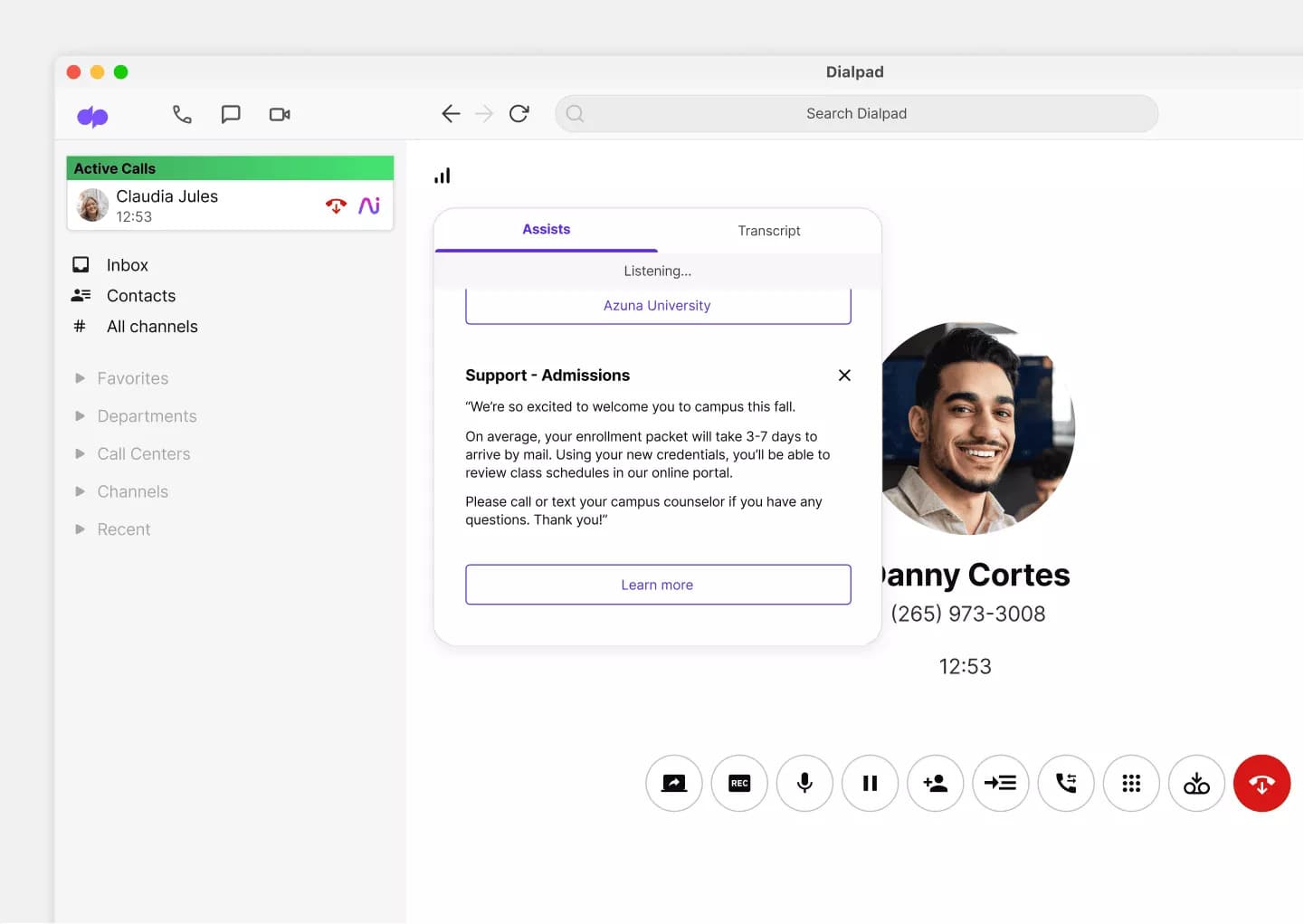Outstanding customer service brings your customers coming back for more, therefore it’s vital to continually measure and improve how you and your team communicates. But what exactly is customer communications?
In this post, we’ll cover customer communications best practices, how to improve it, and provide concrete steps on effective communication. By taking the time to understand improve your existing customer communications strategies, you can reap many benefits for your business, your employees, and your customers.
Why customer communications is important
In today's competitive business landscape, it's more important than ever to provide excellent customer care and support. Remember that customer communications is not only about your inbound enquiries—your outbound communications are just as critical. By delivering superior customer service, you can differentiate your business from the competition, build customer loyalty, and increase sales.
Finally, effective customer communications can help you resolve issues and complaints more quickly and efficiently, which improves response times, average handle time (AHT), and other important metrics. By taking the time to listen to your customers' concerns and address them effectively, you can prevent small problems from turning into bigger ones.
How to improve customer communications
Take advantage of AI and automation
Customer communications and AI technology has evolved to help automate and improve the process of communication between businesses and their customers.
There are a number of ways AI can be used to improve customer communications, such as by automating repetitive tasks, using an AI chatbot to provide real-time customer support, and increasing the accuracy of customer data.
By using AI to automate customer communications, businesses can free up time for employees to focus on more complex tasks, provide a higher level of service, and improve customer satisfaction. In addition, AI can help businesses to better understand their customers through analysing customer data and providing insights that would not be possible with manual methods.
Train reps on active listening techniques
Active listening is a technique that customer service representatives can use during a customer interaction to encourage customers to open up, and it involves paying close attention to what the customer is saying, both verbally and non-verbally. It also involves paraphrasing what the customer has said and asking questions to clarify understanding.
Some tips for active listening include:
Make eye contact with the customer.
Avoid interrupting the customer while they are speaking.
Ask questions to clarify understanding.
Avoid making assumptions about what the customer wants or needs.
Be patient with the customer and allow them to speak without interruption.
With Dialpad, you can create Real-Time Assist (RTA) cards, which are informational cards that automatically appear on your rep’s screen when a customer (or your rep) says a certain keyword or phrase. These not only allow your reps to actively listen to your customer, but also provide them with exactly what the rep should say in that situation:

Prioritise asking open-ended questions for a better customer experience
Asking open-ended questions helps you understand customer needs. By doing so, you can encourage customers to open up and provide more detailed information about their problem or enquiry. Asking closed questions that can be answered with a simple 'yes' or 'no' will not give you the same level of insight into customer needs.
When asking questions, avoid leading questions that prompt the customer to give a particular answer. For example, instead of asking 'Are you happy with our product?', you could say 'What do you think of our product?'. Leading questions can bias the results of your enquiry.
Use a good omnichannel communication strategy
Oftentimes, a customer journey is composed of different channels and touchpoints, including telephone, email, social media and SMS/text messaging. It’s important to train your team on how to use the various channels and make sure they are providing consistent messages across all channels. At the same time, your templates need to be tweaked depending on the channel.
For example, the wording you use in an email may be too long for a text message. You should regularly audit the templates that your team uses and ensure the overall message are streamlined so that customers aren’t getting mixed or contradictory information.
Track key customer metrics
When it comes to customer communications, it is important to track key metrics in order to gauge the success of your efforts. There are a few different metrics you can track, but the most important ones are customer satisfaction (CSAT) scores, first contact resolution (FCR) rates, and net promoter scores (NPS).
Customer satisfaction (CSAT) scores measure how satisfied customers are with the service they received. The downside of this type of metric is that the data you receive is often skewed by highly satisfied and highly dissatisfied customers—in fact, only about 5% of customers respond to CSAT surveys.
With Dialpad’s Ai CSAT, you can now get customer satisfaction scores for all of your calls. This feature infers customer satisfaction for your conversations with high accuracy:

Aside from CSAT, there are a few other less important metrics you can track as well, such as time to resolve (TTR) and customer effort score (CES). Figure out which metrics make the most sense for your organisation. By tracking these key metrics, you will be able to gauge the success of your customer communications strategy and make necessary adjustments accordingly.
8 tips to communicate effectively with customers
1. Be polite and respectful at all times
It should go without saying that being polite and respectful to customers is essential in providing good customer service. This means using phrases like “please” and “thank you”, not interrupting them, and listening to their concerns without judging them.
If a customer is waiting in a queue—whether in-person or virtual (such as over the phone), it’s important to make sure customers know how long they will have to wait, for instance, and keep them updated if the wait time changes. This helps to avoid frustration and angry outbursts, which nobody wants.
For customers that are calling you, instead of placing them on hold, consider using a contact centre that allows customers to request a callback. This helps them keep their place in a virtual queue while they are free to do something else while they wait.
2. Be patient and understanding, even if the customer is angry or upset
Customers reach out to customer service when they need help with something. They might’ve received the wrong item or something was missing from their order. When this happens, it may be difficult for them to be calm and patient when they are feeling upset.
First, remember that the customer is not angry or upset with you personally. They are simply frustrated with the situation they are in. Second, try to see the situation from the customer's perspective. What might be causing their frustration? Is there anything you can do to help them? Finally, take a deep breath and remember that you are professional and capable of handling this situation. With patience and understanding, you will be able to resolve the issue and help the customer move on.
3. Listen to the customer and let them know that you are listening
If a customer is angry, upset, or simply confused, the best thing you can do is to listen to the customer and let them know that you are listening. This means that you should not only be listening to what the customer is saying, but also trying to understand their perspective. Pay attention to their body language (if in-person), the words that they use, and their tone of voice, as this can give you clues about how they are feeling.
Once you have listened to the customer, you should then let them know that you have understood their problem. Show that you are taking their issue seriously and are invested in finding a resolution.
If you do not have the authority to resolve the issue yourself, then escalate it to someone who does. Keep the customer updated on the status of their issue and let them know when it has been resolved.
4. Ask questions to clarify what the customer is saying
When communicating with customers, it is important to ask questions in order to clarify what they are saying. This ensures that you fully understand the problem and can provide an accurate solution. Some questions you may want to ask include:
Can you explain that in more detail?
I'm sorry, I didn't quite catch that. Could you please repeat it?
Could you give me an example of what you're experiencing?
Asking questions is an important part of effective communication with customers. It shows that you care about resolving their issue and that you want to make sure you have all the information necessary to do so. By clarifying the problem, you can provide a better and more accurate solution.
5. Repeat back what the customer has said to ensure that you understand their issue
One of the most important things you can do when communicating with a customer is to summarise what they said and repeat it back. This ensures that you have correctly understood the problem and can provide an accurate solution. It also shows the customer that you care about resolving their issue.
In some cases, customers may not be able to articulate their problem clearly. In these cases, it is important to ask questions in order to try and understand their perspective. Once you have gathered all of the information, you can start working on a solution.
6. Offer solutions or options to the customer
When you are communicating with a customer, it is important to provide them solutions or options. This shows that you are trying to help them resolve their issue.
For example, if an item is out of stock, instead of just offering a refund, what other options are available? For example, can the customer get upgraded to a product that is in stock? Having a few options can help diffuse tensions so that the customer can choose how they’d like to proceed.
7. Follow up with the customer after resolving their issue
Once you have resolved the customer's issue, it is important to follow up with them to ensure that they are satisfied with the resolution and receive any customer feedback that they might have. This can be done by sending a follow-up email or giving them a call.
Following up with customers shows that your business cares about customer satisfaction and wants to ensure that they are happy with the resolution. It also gives you an opportunity to resolve any outstanding issues that may have arisen.
8. Thank the customer for their business
Before the end of your service experience for a customer, it’s important to let them know that you are always there to help resolve any issues they may have in the future. This is especially true for long-time customers of your business. Some phrases you can say include:
Thank you for your business.
We appreciate your patronage and are always here to help resolve any issues you may have in the future.
This helps end a conversation on a positive note and leaves a good impression.
Optimise your communications
If customer success truly is a priority to your organisation, it’s essential to constantly monitor how your team is doing in order to improve how your team handles customers. With the right tools and strategy, it’s easy to make sure that your team’s communications lead to enhanced customer relations and high customer retention.
Whether it’s listening in on certain calls, monitoring customer sentiment and CSAT scores, or providing your team with training so that they are up-to-date on the best practices for good communication, there are many steps that you can take to improve in this area of customer service.
Want to manage all your customer communications in one place?
Book a demo to see how businesses are handling all channels, from voice to digital to social, in one app with Dialpad Ai Contact Centre. Or, take a self-guided interactive tour of the app on your own!

